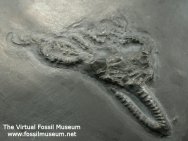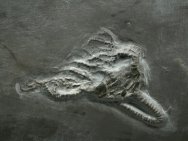Codiacrinus
schultzei
Phylum
Echinodermata; Order Cladida; Family Codiacrinidae
Geological
Time: Lower Devonian Seigenian/Emsian Stage
Size: Calyx:
45 mm by 30 mm with 45 mm stem attached on a 198 by 157 mm matrix
Fossil
Site: Hunsruck Slate, Bundenbach, Germany
 This
exceptionally well preserved specimen is the Cladid crinoid known
as Codiacrinus schultzei. The Hunsruck slate is famous for its fossils,
many of which have pyritization present. Rapid burial and pyritization
was what led to the many wonderful examples of early Devonian life
from the region. The chemistry of the silt was such that low organic
content and high levels of iron and sulfur allowed the pyrite to
diffuse into the tissues rather than be deposited in the sediment.
The mudstones were metamorphosed into slate during the Carboniferous.
The slate was quarried for roofing tiles, and the quarrymen would
save the fossils for later sale. Now that the quarries are no longer
open, fossils of these wonderfully preserved benthic organisms will
only come from existing collections. This one is quite complete,
and includes an attached section of stem. Its pyritization serves
as an artistic counterpoint to the rich black slate, making for
a truly striking fossil. This
exceptionally well preserved specimen is the Cladid crinoid known
as Codiacrinus schultzei. The Hunsruck slate is famous for its fossils,
many of which have pyritization present. Rapid burial and pyritization
was what led to the many wonderful examples of early Devonian life
from the region. The chemistry of the silt was such that low organic
content and high levels of iron and sulfur allowed the pyrite to
diffuse into the tissues rather than be deposited in the sediment.
The mudstones were metamorphosed into slate during the Carboniferous.
The slate was quarried for roofing tiles, and the quarrymen would
save the fossils for later sale. Now that the quarries are no longer
open, fossils of these wonderfully preserved benthic organisms will
only come from existing collections. This one is quite complete,
and includes an attached section of stem. Its pyritization serves
as an artistic counterpoint to the rich black slate, making for
a truly striking fossil.
Also
see: Fossils
of the Hunsrück Slate in Bundenbach Germany |
|




